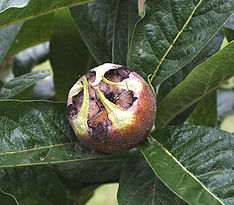Mespilus
| Mespilus | |
|---|---|

| |
| Common medlar foliage and fruit | |
| Scientific classification | |
| Kingdom: | Plantae |
| Clade: | Tracheophytes |
| Clade: | Angiosperms |
| Clade: | Eudicots |
| Clade: | Rosids |
| Order: | Rosales |
| Family: | Rosaceae |
| Subfamily: | Amygdaloideae |
| Tribe: | Maleae |
| Subtribe: | Malinae |
| Genus: | Mespilus Bosc ex Spach |
| Species | |


Mespilus, commonly called medlar, is a monotypic genus of flowering plants in the family Rosaceae containing the single species Mespilus germanica of southwest Asia. It is also found in some countries in the Balkans, especially in Albanian and Bulgarian regions, and in western parts of Caucasian Georgia. A second proposed species, Mespilus canescens, discovered in North America in 1990, proved to be a hybrid between M. germanica and one or more species of hawthorn, and is properly known as × Crataemespilus canescens.[1]
Plant
[edit]Mespilus forms deciduous large shrubs to small trees growing up to 8 m (26 ft) tall. The fruit is a matte brown pome.
History
[edit]Mespilus germanica is apparently native only to southwest Asia and southeastern Europe, i.e. near the Black Sea coast and western Mediterranean, and Asia Minor, as well as the Caucasus and northern Iran, but it has an ancient history of cultivation and wild plants exist in a much wider area; it was grown by the ancient Greeks and Romans, beginning in the second century BC. It was a very popular fruit in Western Europe during the Middle Ages, but has fallen out of favour there.[2]
Extant Species
[edit]| Image | Scientific name | Common Name | Distribution |
|---|---|---|---|
 |
Mespilus canescens | Stern's medlar | Prairie County, Arkansas, United States |
 |
Mespilus germanica | medlar or common medlar | Tabaristan (Iran), southwest Asia and also southeastern Europe |
Related plants
[edit]Within the subfamily Amygdaloideae, Mespilus is most closely related to Crataegus, Amelanchier, Peraphyllum, and Malacomeles.[3]
Many authors group Mespilus together with Crataegus in a single genus. When thus combined, the correct species name is Crataegus germanica (L.) Kuntze.[4][5][6][7][8][9]
The common name “snowy mespilus” attaches to certain species of Amelanchier, notably Amelanchier × lamarckii and Amelanchier ovalis.
The genus Eriobotrya was once considered to be closely related to Mespilus. The loquat, one of several Eriobotrya species, was formerly thought to be closely related to the genus Mespilus, and is still sometimes known in some European countries as a medlar and is still sometimes called the "Japanese medlar".
Fruit
[edit]Mespilus germanica features an unusual apple-like fruit. In southern Europe, the medlar fruit ripen fully and can be eaten off the tree, but in northern climates, they require bletting to eat.[10] This process involves ripening fruit off the tree, usually in a bowl, until soft. Each fruit contains a half dozen or so hard, irregularly shaped seeds that require stratification to germinate. Many cultivars exist, and they are increasingly popular selections carried by perennial and edible landscaping nurseries in North America.
References
[edit]- ^ Flora of North America
- ^ Baird, J.R.; Thieret, J.W. (1989). "The Medlar (Mespilus germanica, Rosaceae) from antiquity to obscurity". Economic Botany. 43 (3): 328–372. doi:10.1007/BF02858732.
- ^ Campbell, C.S.; Evans, R.C.; Morgan, D.R.; Dickinson, T.A.; Arsenault, M.P. (2007). "Phylogeny of subtribe Pyrinae (formerly the Maloideae, Rosaceae): Limited resolution of a complex evolutionary history". Plant Systematics and Evolution. 266 (1–2): 119–145. CiteSeerX 10.1.1.929.4379. doi:10.1007/s00606-007-0545-y. JSTOR 23655780.
- ^ Scopoli, G.A. (1760). Flora Carniolica Exhibens Plantas Carniolae Indigenas et Distributas in Classes Naturales cum Differentiis Specificis, Synonymis Recentiorum, Locis Natalibus, Nominibus Incolarum, Observationibus Selectis, Viribus Medicis. p. 583.
- ^ Castiglioni, L.G. 1790. Luigi Castiglioni's Viaggio travels in the United States of North America 1785–1787 with natural history commentary and Luigi Castiglioni's Botanical Observations: Viaggio negli Stati Uniti dell' America Settentrionalle fatto negli Anni 1785, 1786 e 1787....
- ^ Moench, C. 1794. Methodus Plantas Horti Botanici et Agri Marburgensis: Reprint with introduction and biography by William T. Stearn. Otto Koeltz Antiquariat, Koenigstein-Taunus.
- ^ Koch, K. 1869. Dendrologie: Bäume, Sträucher und Halbsträucher, welche in Mittel- un Nord- Europa in Freien kultivirt werden. Verlag von Ferdinand Enke, Erlangen.
- ^ Kuntze, O. (1891). Revisio generum plantarum. Vol. 1. Leipzig: A. Felix. p. 215.
- ^ Lo, E.; Stefanović, S.; Dickinson, T.A. (2007). "Molecular reapprasial of relationships between Crataegus and Mespilus (Rosaceae, Pyreae) – Two genera or one?". Systematic Botany. 32 (3): 596–616. doi:10.1600/036364407782250562. JSTOR 25064271.
- ^ Eichhorn, Markus (July 2011). "Nottingham Medlar". Test Tube. Brady Haran for the University of Nottingham.
